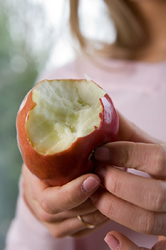Are Certain Foods Making Your Spring Allergies Worse?
by www.SixWise.com
Do you suffer from hay fever or other seasonal allergies yet find that when you eat certain fresh fruits and vegetables, you get a strange, tingly, itchy sensation in your mouth?
|

For some people with pollen allergies, taking a bite of an apple or other fresh fruits and veggies can cause an allergic reaction that makes their mouth tingle and itch.
|
If so, you could have food-pollen allergy syndrome, also known as oral allergy syndrome.
Evidence suggests that in some people with seasonal allergies, their immune system mistakes a plant protein in certain fruits and vegetables for pollen, resulting in sometimes strange symptoms like:
- Itching in your mouth, lips and back of throat
- Tingling in your mouth
- An itchy tongue
- Throat and lips that feel swollen
"They're not identical proteins, but they're similar enough to confuse the immune system to have these reactions," Dr. Robert Wood, chief of pediatric allergy and immunology at Johns Hopkins Children's Center, told CNN.
Allergy specialists call this a “cross-reaction,” and say that about 25 percent of people with a pollen allergy may suffer from food-pollen syndrome. However, many who experience are completely unaware that their itchy mouth upon eating an apple or cantaloupe has to do with their seasonal allergies.
Food-Pollen Syndrome is NOT a Food Allergy
In the case of a food allergy, you are allergic to a protein in a food, such as peanuts, and the corresponding immune system reaction impacts your whole body.
With food-pollen syndrome, however, your allergy is to pollen. It’s only when you eat a food with a similar protein structure to pollen that you have a reaction, and the reaction is short-term and confined to your mouth and throat because the offending plant proteins cannot survive the acids and enzymes in your digestive system. Only in rare cases will food-pollen syndrome lead to anaphylaxis, with can cause blocked airways and high blood pressure, and may be life-threatening.
There are two ways to determine if your allergy symptoms are due to food-pollen syndrome:
- The symptoms are confined to your mouth, lips and throat, and they go away in 10-30 minutes
- You only have the problem when you eat raw fruits and vegetables, as opposed to cooked versions (cooking appears to destroy or inactivate the allergic proteins)
Which Foods are Cross-Reactive to Which Allergies?
According to the Mayo Clinic, if you’re allergic to birch pollen, you may also have a reaction to:
- Apples
- Carrots
- Celery
- Hazelnuts
- Peaches
- Pears
- Raw Potatoes
If you’re allergic to ragweed pollen, you may react to:
- Bananas
- Melons (cantaloupe, honeydew and watermelon)
- Tomatoes
If you’re allergic to grasses, you may react to:
If you’re allergic to mugwort pollen, you may react to:
- Apples
- Carrots
- Celery
- Kiwis
- Peanuts
- Certain spices (caraway seeds, parsley, coriander, anise seeds, fennel seeds)
How to Cope With Food-Pollen Syndrome
Remember, not everyone with a seasonal allergy experiences food-pollen syndrome, but if you do cooking fruits and vegetables can help you avoid a reaction. If your symptoms are confined to your mouth and you don’t want to give up on raw produce, either for the taste or the health benefits, you don’t have to.
"Patients will typically decide on their own, without any discussion with a doctor, whether they enjoy the apple [or other offending food] enough to put up with an itchy mouth, or whether they hate the itchy mouth enough to avoid the apple," Dr. Wood said on CNN.com.
There are other tricks, too, that can help to reduce your food-pollen syndrome symptoms:
- Try removing the peel from the fruit or vegetable
- Opt for freshly picked varieties (storing foods increases the amount of allergen)
- Try a different variety of the food
- Rinse your mouth with water after you eat the offending food
You may also notice that you only react to raw fruits and vegetables during the season your pollen allergy is most active. In fact, typically as your pollen allergy improves, so will food-pollen syndrome. Fortunately, there are numerous ways to keep seasonal allergies from interfering with your health, and we’ve listed some of the top ones below.
10 Simple Ways to Fight Seasonal Allergies
1. Keep your windows closed to keep pollen out (this is especially important from 5 a.m. to 10 a.m. when plants release most of their pollen). This includes while you’re driving.
2. Use your air conditioner instead of opening windows, and ideally use an air conditioner that has an allergy-reducing HEPA filter in it.
|
Keep Dirt, Dust and Allergens Out of Your Home With PerfectClean Cloths, Dusters and Mitts

PerfectClean is the line of cleaning tools that leading hospitals and health care organizations use for several reasons:
- The ultramicrofiber construction picks up far more dust, dirt and biological contaminants than any other cleaning tool, so your home is significantly cleaner
- Unlike chemical cleaners and typical mops and sponges, which are loaded with germs, PerfectClean products are 100% safe due to their ultramicrofiber construction
- Hospitals and other organizations use them 100 times or more ... so they will save you money as you can eliminate chemical cleaners and avoid constantly replacing towels, mop heads, etc.
Due to the positively charged ultramicrofibers, these cloths, mops and dusters pick up everything in their path including dust, crumbs, pet hair, lint and contaminants invisible to the naked eye. Use them wet or dry -- only water is needed!
Read More and Order Your PerfectClean Cleaning Tools Now!
|
3. Check the daily pollen and mold counts (AAAAI's National Allergy Bureau has daily pollen counts for locations across the country). If counts are high, stay indoors as much as possible. Also stay indoors if it's windy, as dust and pollen will be blown about.
When pollen and mold counts are high, spend more time indoors.
4. Wash your bedding once a week in hot water to help get rid of dust mites and other allergy triggers. Even better, throw in a 100% Hypoallergenic Static Eliminator Reusable Dryer Sheet with your dryer load to take static cling out and soften fabric -- without any toxic and potentially allergenic chemicals
5. Clean your home frequently to reduce pollen, mold, dust and other allergens. The PerfectClean line of mops, dusters, towels and more, which is used by leading hospitals and other health care organizations, is ideal for this. Rather than just pushing dust around, or worse, stirring it up into the air, PerfectClean's EasyGrip Mop and Flexible Duster are made with positively charged ultramicrofibers that pick up everything in their path -- including dust and all of its microscopic attachments.
6. If you spend time outside, change your clothes and wash your hair when you come inside to remove pollen and other allergens. Also resist the temptation to hang your clothes out in the sun to dry. When you bring them inside, they'll be covered in pollen and mold.
7. Filter your home's air -- many allergic reactions are triggered by airborne particles. Sixwise highly recommends the PIONAIR Air Treatment System, as unlike most air purifiers, the PIONAIR™ Air Treatment System doesn't wait for pollutants to contact a filter or plate. Instead, the PIONAIR generates air-purifying technology that migrates through the area and neutralizes organic odors, microbes, & molds at their source. As a result, the PIONAIR produces fresh clean air throughout your home uniformly, by addressing the pollutant source -- without the use of fans, filters, or plates!
8. Have someone else mow your lawn. Cutting the grass will expose you to a host of pollens and molds (the same goes for raking leaves in the fall).
9. Wipe off surfaces you touch often. Surfaces such as computer keyboards, countertops, furniture, door handles and appliances can be loaded with allergens. When you touch these areas, the allergens are transferred to your hands and then likely to your eyes, nose and mouth, potentially worsening your symptoms. Giving these areas a quick wipe with PerfectClean high-quality, commercial-grade microfiber cloths will keep all types of allergens to a minimum.
10. An astounding 85 percent of household "dirt" is carried into your house from the outside, so strategically placing high-quality mats in highly trafficked areas like entrances can dramatically reduce the amount of dirt, dust and allergens that are tracked into your home (and spread via your indoor air).
It is key to use the right type of mats -- AVOID cotton, coir and other fibers, and wood and metal mats, as they can increase versus help the problem. The Waterhog Grand Premier mats are our top-recommended choice for a "healthy" mat (that also looks great!).
Recommended Reading
Why are Kids Allergies on The Rise? An Important Overview
26 Simple & Smart Steps to Prevent Allergy Flare-Ups
Sources
CNN.com April 8, 2009
ABC News April 6, 2009
MayoClinic.com Food Allergy Symptoms